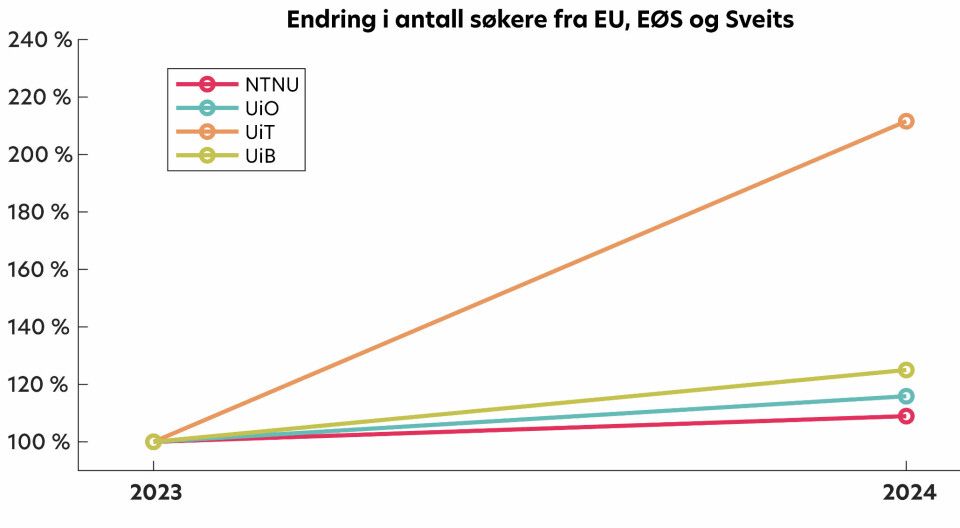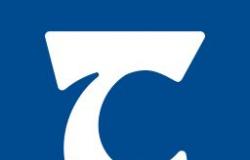After the tuition fee was introduced last year, NTNU lost a large proportion of its international students. Students from outside the EU now had to pay tuition fees to study in Norway.
What had previously been a large and important student group for NTNU disappeared almost overnight, and on some study programs no international students showed up for the start of their studies.
Helene was the only one who showed up for the start of her studies
To make up for the loss, several study programs at NTNU should start recruiting more from other student groups. One of these was students within the EU, who do not have to pay tuition fees.
According to figures Universitetsavisa has obtained access to, NTNU has only marginally succeeded in obtaining more applicants within the EU. UiO and UiB have managed to recruit somewhat more, while UiT has doubled its number of applicants.
See the full overview in the tables at the bottom of the case.
Dramatic drop in the number of applicants
Seen in relation to 2023, the proportion of international applicants from outside the EU has fallen by 88 per cent. This means that the international numbers of applicants to NTNU (within and outside the EU) have collectively fallen by 81 per cent in one year.
Although several programs at the university had ambitions to increase the recruitment of students from the EU, the proportion of EU applicants has only increased by 9 percent overall from last year to this year, from 526 to 573. The number of EU applicants is still below what it was in 2021 when there were 695 applicants in this group.
Historically, students from outside the EU have been an important student group for NTNU, while the proportion of EU applicants has always been low. In 2021, 7.5 per cent of the international applicants were from countries within the EU. Now that the number of applicants from outside the EU has fallen drastically, this proportion has increased to a whopping 39 per cent.
Still faculty-wise responsibility
Responsibility for recruitment to the international master’s programs at NTNU has long rested with the faculties. After the announcement that a tuition fee would be introduced for students from outside the EU, NTNU centrally agreed to put in place a joint recruitment strategy. This is planned to be completed by the end of 2024.
NTNU must rethink the recruitment of international students: – We do not have the expertise
Vice-rector for education, Marit Reitan, says that the reason it is taking time is capacity challenges due to reorganization in the joint administration.
– At the same time, this is a new area of work for which resources have not been allocated before. International recruitment is part of the work on new guidelines for NTNU’s recruitment work, which is scheduled to be completed by the end of 2024.
This means that recruitment for admission both for this year and next year is still with the faculties and the individual study programmes.
Has doubled the number of applicants
One of the universities UA has obtained figures from has already managed to recruit several EU applicants. At UiT, since 2023 they have more than doubled the number of applicants from within the EU – from 190 to 402.

Pro-rector for education at UiT, Kathrine Tveiterås, says that they have worked systematically with the recruitment of students from the EU.

– It is great that it is producing results, and we are very pleased with the trend, she says.
– What do you think of the fact that you have worked systematically with the recruitment of students from the EU?
– UiT has actively participated in the European education conference, EAIE, prioritized dialogue with our partners and marketed our English-language programs – also in Keystone Academic, which is a marketing portal, says Tveitås.
She also says that they see that several of those who have been on an exchange stay with them as bachelor students return to take a master’s programme.
Although UiT will continue to work to get more EU applicants in the coming years, Tveiterås believes that more European students will not replace other international students.
– Diversity in background and perspective is important for the development of knowledge, she notes.
No common measures
Although no one can compare with UiT, both UiO and UiB have had a greater increase in EU applicants than NTNU. At UiO, the number of European applicants has increased by 16 per cent since 2023, and at UiB the number has increased by 25 per cent.
UiO has not introduced central measures for recruitment from the EU. Like NTNU, only the various faculties carry out active recruitment measures.
Unable to fill up the programs with Nordic and European applicants
– It is carried out to varying degrees, in addition to good information online, says study director Hanna Ekeli.
She says that UiO is considering the need to implement joint recruitment measures for students from countries outside the EU/EEA and Switzerland.
UiB also explains its rise in part by the fact that the individual professional communities have actively stepped in to recruit EU students, in order to cover the loss of applicants from outside the EU/EEA.
– But other influencing factors could be that Norway has become a cheaper country to live in, and that it is a safe and stable country in an otherwise troubled world, says department director Christen Soleim at the Department of Studies at UiB.
Applicants from the EU, EEA and Switzerland
| University | 2021 | 2022 | 2023 | 2024 |
| NTNU | 696 | 531 | 526 | 573 |
| UiO | 1064 | 933 | 870 | 1008 |
| UiT | 216 | 206 | 190 | 402 |
| UiB | 480 | 365 | 440 | 550 |
Applicants from outside the EU, EEA and Switzerland
| University | 2021 | 2022 | 2023 | 2024 |
| NTNU | 8520 | 9243 | 7327 | 886 |
| UiO | 4875 | 3753 | 4134 | 889 |
| UiT | 2805 | 4140 | 3707 | 641 |
| UiB | 3155 | 3950 | 3875 | 525 |









